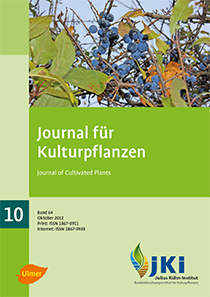Mould fungi on grapes – pathogen complex, mycotoxins and strategies of control
DOI:
https://doi.org/10.5073/JfK.2012.10.02Keywords:
Penicillium, Botrytis, sour rot, secondary metabolites, geosmin, mycotoxins, wine quality, mould controlAbstract
Botrytis cinerea (grey mould), Penicillium spec. (blue mould) and yeasts causing sour rot are the most important bunch rot pathogens in German vine growing regions. Penicillium species involved in rot of grapes produce secondary metabolites with significant impact on quality of must or wine and also on food safety. P. expansum, for instance, is the causal agent of blue mould on grapes and produces the volatile compound geosmin. Unfortunately, even a low level of geosmin may lead to a persistent earthy and musty smell of the wine. The role and biological function of geosmin and other secondary metabolites as well as environmental factors that may trigger their production are currently investigated. The project is supported by the German Federal Ministry of Food, Agriculture and Consumer Protection (BMELV) through the Federal Office for Agriculture and Food (BLE 2810HS016).
In contrast to the pathogen B. cinerea that may infect grape berries via wounds or by a direct penetration of the berry skin, P. expansum and sour rot pathogens are addicted solely to wounds for infection. Until now, there are no fungicides available that are effective against Penicillium spec. or sour rot pathogens on grapes. Therefore, control strategies mainly consider cultivation methods that help to avoid wounds on the berries. Different methods are used to change bunch structure in case for those grape varieties exhibiting an unfavourable compact bunch architecture. Among them, especially horizontal bunch dividing, hand stripping of berry rudiments, and the application of growth regulators are the most effective strategies to avoid wounds on berries and also infections leading to bunch rot.
Downloads
Published
Issue
Section
License
The content of the journal is licensed under the Creative Commons Attribution 4.0 License. Any user is free to share and adapt (remix, transform, build upon) the content as long as the original publication is attributed (authors, title, year, journal, issue, pages).
The copyright of the published work remains with the authors. The authors grant the Journal of Cultivated Plants, the Julius Kühn-Institut and the OpenAgrar repository the non-exclusive right to distribute and exploit the work.







